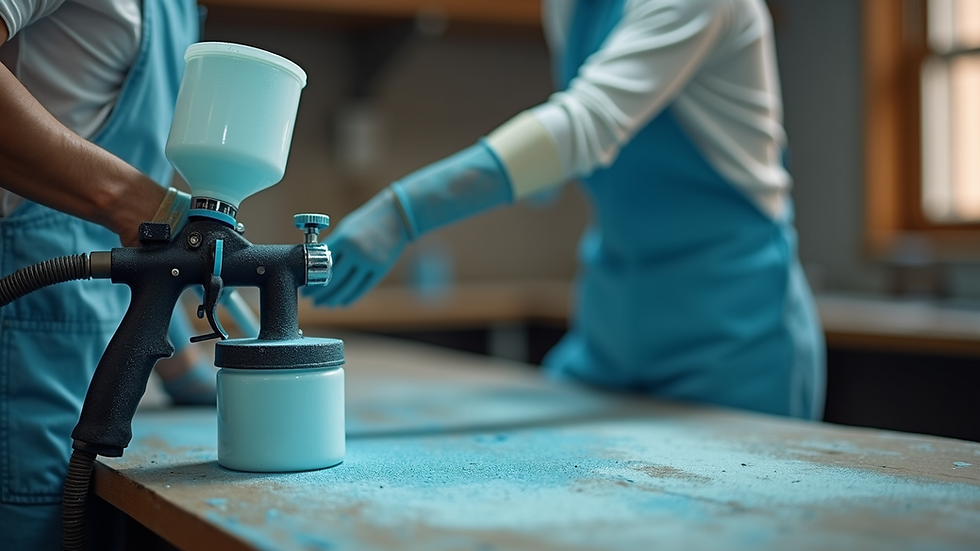Solve Common Paint Sprayer Issues Quickly
- Greg Bittner
- Jul 8
- 3 min read
Paint sprayers are fantastic tools that can save you time and effort when it comes to painting large surfaces. However, like any other equipment, they can encounter problems. Understanding these paint sprayer problems and how to resolve them quickly is crucial for ensuring smooth operation and achieving the finish you desire. In this post, we will discuss common issues that paint sprayers face and how to troubleshoot them effectively.

Understanding Common Paint Sprayer Problems
As with any technology, paint sprayers can develop various issues over time. Some of the most frequent problems include clogging, inconsistent spray patterns, and equipment failure. Knowing how to identify these issues early and provide quick fixes can help you avoid delays in your project.
1. Clogging: Clogged nozzles are one of the most common issues. When the paint thickens or small particles get stuck, it can disrupt the spray pattern, leading to uneven coats.
2. Inconsistent Spray Patterns: If your paint sprayer is leaving patches or has a sputtering spray, it may indicate that something is wrong with the fluid delivery system.
3. Equipment Malfunctions: Mechanical issues can also arise, such as a faulty motor or a loose connection. These can halt your work and require immediate attention to prevent damage.
Common Paint Sprayer Problems and Their Causes
Paint sprayer problems can stem from various factors. By understanding these potential causes, you can avoid them in the future.
1. Viscosity of Paint
The thickness of your paint can significantly affect how it flows through the sprayer. If the paint is too thick, it may cause clogging, while paint that is too thin can result in excessive overspray.
2. Dirty Equipment
A dirty paint sprayer, particularly its filters and nozzles, can lead to clogging and poor performance. Keeping your equipment clean will go a long way in maintaining its function.
3. Incorrect Settings
Using the wrong pressure or nozzle size for your specific paint can create application issues. Always refer to the manufacturer's guidelines for optimal settings.
4. Damaged Parts
Unfortunately, parts can wear out or become damaged over time. Regular inspections of your equipment are necessary to replace anything that looks worn.

How to Fix a Paint Sprayer That Won't Spray?
If your paint sprayer isn’t spraying, it can be frustrating, but often the fix is simple. Here are steps you can take to troubleshoot:
Check the Power Supply: Ensure your sprayer is plugged in and the outlet is working. If using a battery-operated model, check the battery charge.
Inspect for Clogs: Start by checking the nozzle and filters. Clean them thoroughly to remove any paint build-up.
Look at the Paint: Ensure your paint is adequately thinned based on the manufacturer's recommendations. Use a viscosity cup to check if the paint is too thick.
Adjust the Pressure: If the pressure settings are too low, it may prevent the paint from being pushed out. Increase the pressure and see if that resolves the issue.
Check Hoses and Connections: Make sure all connections are secure and that there are no kinks or breaks in hoses that could affect fluid movement.
If these steps don’t resolve your issue, consider diving deeper into paint sprayer troubleshooting resources for further guidance.

Tips for Maintaining Your Paint Sprayer
Proper maintenance can dramatically reduce the chance of encountering issues. Here are some effective tips:
Clean Your Sprayer Regularly: After every use, disassemble the sprayer and clean all parts thoroughly. Use warm, soapy water or a suitable solvent depending on the paint type.
Check Filters: Regularly inspect and clean or replace filters. This step can prevent significant clogging issues.
Store Correctly: Keep your sprayer in a dry, clean environment. Avoid extreme temperatures that might damage its components.
Test Before Major Jobs: Always perform a test spray before beginning a significant project. This can help ensure everything is working correctly.
Read the Manual: Make sure to refer to your specific sprayer's manual. It often contains useful information about common issues and their solutions.
When to Seek Professional Help
Sometimes, despite your best efforts, a problem persists. If you notice:
Persistent Malfunctions: If your sprayer continues to have issues even after troubleshooting, it might be a more serious mechanical failure.
Unusual Sounds or Vibrations: These may indicate internal problems that could worsen if not addressed.
Heating Up: If your sprayer gets excessively hot during use, it can indicate a motor issue and could be dangerous.
At this point, it’s wise to consult a professional or contact your manufacturer for support.
In summary, being aware of paint sprayer problems and their solutions can significantly increase your efficiency and effectiveness during painting projects. By following proper maintenance routines and addressing issues quickly, you will spend less time battling equipment and more time creating beautiful finishes.







Comments